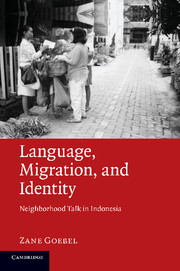Book contents
- Frontmatter
- Contents
- Figures
- Diagrams
- Maps
- Tables
- Extracts
- Preface
- Conventions
- 1 Introduction
- 2 Long-term Processes of Enregisterment
- 3 Enregistering Local Practices and Local Spaces
- 4 Linguistic Signs, Alternation, Crossing, and Adequation
- 5 Women, Narratives, Identity, and Expectations in Ward 8
- 6 Learning to Become a Good Ward Member
- 7 Emerging Identities in a Monthly Ward 8 Male Meeting
- 8 Chineseness as Deviance
- 9 Language Ideologies and Practice in Ward 5
- 10 Conclusions
- Notes
- References
- Index
7 - Emerging Identities in a Monthly Ward 8 Male Meeting
Published online by Cambridge University Press: 04 August 2010
- Frontmatter
- Contents
- Figures
- Diagrams
- Maps
- Tables
- Extracts
- Preface
- Conventions
- 1 Introduction
- 2 Long-term Processes of Enregisterment
- 3 Enregistering Local Practices and Local Spaces
- 4 Linguistic Signs, Alternation, Crossing, and Adequation
- 5 Women, Narratives, Identity, and Expectations in Ward 8
- 6 Learning to Become a Good Ward Member
- 7 Emerging Identities in a Monthly Ward 8 Male Meeting
- 8 Chineseness as Deviance
- 9 Language Ideologies and Practice in Ward 5
- 10 Conclusions
- Notes
- References
- Index
Summary
Introduction
In Section 2.5. I noted that while representing little more than 2 percent of Indonesia's population, those of Chinese ancestry have been stereotyped as “deviant non-indigenous foreign others” and positioned as scapegoats in times of political and economic turmoil. During such times of turmoil they have been socially identified by masses – despite being largely physically undifferentiable from other Indonesians – and subject to acts of violence against property and person. Drawing on written inter-group communications, group manifestos, speeches, newspapers and interviews, historians have noted that this mass violence often evolved from a combination of local problematic interactions, widely held prejudices, and the actions of groups who benefited from instability (e.g. Coppel, 1983; Purdey, 2006). While eminently useful, such accounts provide narratives that give an appearance of a hypodermic model where representations of signs are received as sent. We know very little about whether, to what extent, and how such signs are “recontextualized” (Bauman & Briggs, 1990) in actual face-to-face interaction.
The next two chapters start to fill this gap by looking at face-to-face interactions that occurred in one urban middle-income space in a period preceded by two occurrences of mass anti-Chinese violence and followed shortly thereafter by the economic meltdown of 1997–1998 (e.g. Purdey, 2006). This meltdown was accompanied by monthly outbreaks of such violence culminating in the well-known lethal mass violence that occurred in Jakarta in mid-May 1998.
- Type
- Chapter
- Information
- Language, Migration, and IdentityNeighborhood Talk in Indonesia, pp. 126 - 146Publisher: Cambridge University PressPrint publication year: 2010



